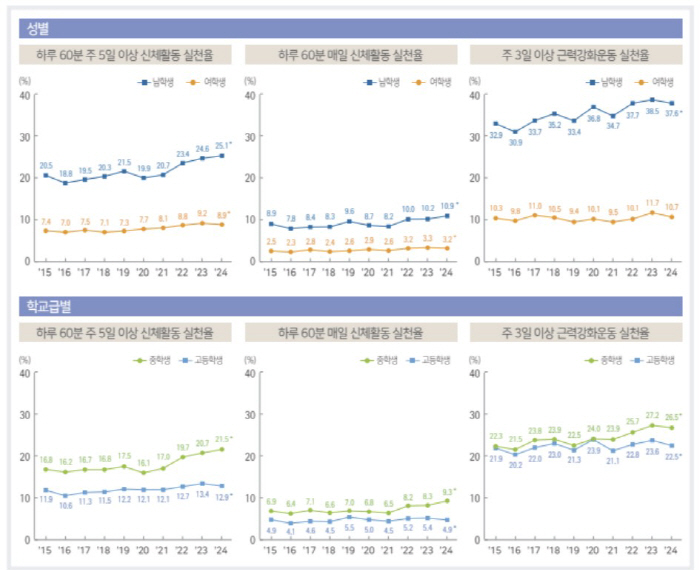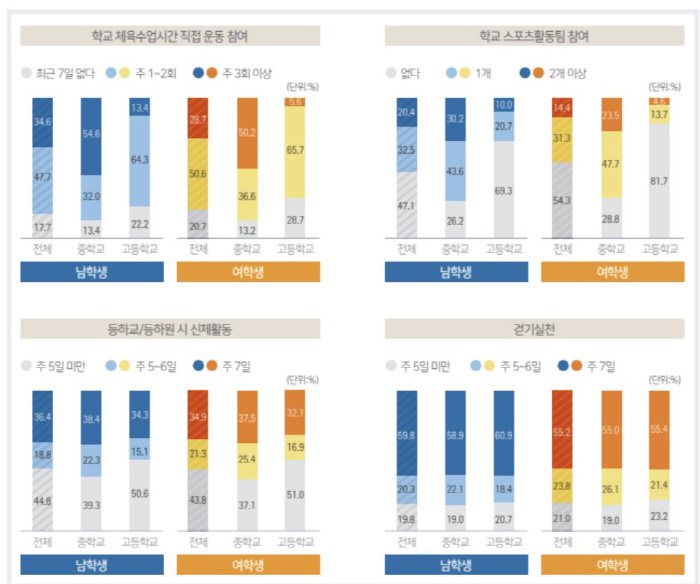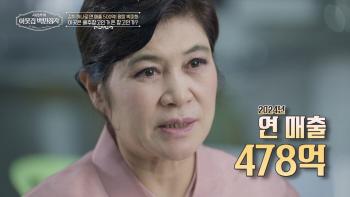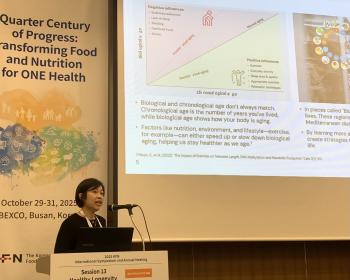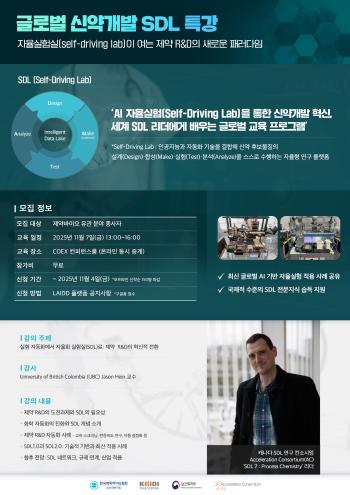Korea's youth physical activity practice rate is 13.4% the lowest in the world
Mar 27, 2025
The rate of physical activity practice of Korean adolescents (the rate of performing breathless aerobic exercise for more than 5 days a day for 60 minutes a week) was 17.3% as of 2024, the lowest in the world.
This is the result included in the first summary statistics of the 2025 'National Health Statistics Plus' published by the Korea Centers for Disease Control and Prevention under the theme of 'Youth Physical Activity Trends and Related Factors' using the results of the Youth Health Behavior Survey.
The Youth Health Behavior Survey investigates aerobic physical activity (physical activity more than 60 minutes a day, high-intensity physical activity), muscle strengthening exercise, and time spent sitting during the week/weekend every year to understand the current status of physical activity. In particular, in 2022, an in-depth survey was conducted on ▲ the number of days of walking practice, ▲ the number of days of physical activity at school/school, ▲ the number of direct exercise participation in physical education classes, and ▲ the number of participation in the school sports activity team.
Compared to the results of a survey of 146 countries conducted by the World Health Organization (WHO) in 2016, the rate of physical activity practice among adolescents in Korea was the lowest. The rate of physical activity practice of high school students is about 30 percentage points lower than that of the United States (as of 2023).
However, statistics show that over the past 10 years (2015-2024), the physical activity practice rate (physical activity practice rate of more than 5 days a week for 60 minutes, muscle strengthening exercise practice rate of more than 3 days a week) has tended to increase, and male students (25.1%) are higher than female students (8.9%), and middle school students (21.5%) are higher than high school students (12.9%). In particular, while the rate of physical activity practice of middle school boys increased significantly, high school girls remained at a low level without any apparent change.
As a result of an in-depth physical activity survey (as of 2022), 59.8% of male students and 55.2% of female students practiced walking for more than 10 minutes every day, and 82.3% of male students and 79.3% of female students exercised directly during school physical education classes more than once a week.
When classified into participating and non-participating groups according to the degree of participation in physical activities and physical activities in school in daily life, students who actively participated in walking or physical activities showed better health behavior due to lack of breakfast and stress perception than non-participating groups, and the obesity rate was lower in the participating group at 10.3% and 11.8% in the non-participating group.
Participating physical activity groups meet all of the following: walking for more than 10 minutes at least 5 days a week, physical activity at school and school for more than 5 days a week, direct exercise participation in school physical education classes at least 3 times a week, and participation in more than one school sports activity team.
Factors related to physical activity practice rate for more than 5 days a week for 60 minutes a day were gender, walking practice, physical activity at school and school, participation in physical and sports activities teams at school, and sedentary activity hours other than weekday learning purposes. In particular, students who practiced walking for more than 10 minutes every day in their daily lives had about three times higher physical activity practice rates than less than five days a week, and students who participated in physical education classes (more than three times a week) and sports activities teams (more than two) had about 2.5 times higher practice rates than students who did not participate.
Ji Young-mi, the head of the Korea Centers for Disease Control and Prevention, emphasized that "the increase in the rate of physical activity practice of adolescents over the past 10 years is a positive change, but it is still at a level that needs to be improved." "Since active participation in physical activity and physical activity at school has a desirable effect on health indicators such as mental health and obesity in daily life, continuous attention and efforts from schools, families, and communities are needed to increase the physical activity of adolescents."
This is the result included in the first summary statistics of the 2025 'National Health Statistics Plus' published by the Korea Centers for Disease Control and Prevention under the theme of 'Youth Physical Activity Trends and Related Factors' using the results of the Youth Health Behavior Survey.
The Youth Health Behavior Survey investigates aerobic physical activity (physical activity more than 60 minutes a day, high-intensity physical activity), muscle strengthening exercise, and time spent sitting during the week/weekend every year to understand the current status of physical activity. In particular, in 2022, an in-depth survey was conducted on ▲ the number of days of walking practice, ▲ the number of days of physical activity at school/school, ▲ the number of direct exercise participation in physical education classes, and ▲ the number of participation in the school sports activity team.
Compared to the results of a survey of 146 countries conducted by the World Health Organization (WHO) in 2016, the rate of physical activity practice among adolescents in Korea was the lowest. The rate of physical activity practice of high school students is about 30 percentage points lower than that of the United States (as of 2023).
|
|
When classified into participating and non-participating groups according to the degree of participation in physical activities and physical activities in school in daily life, students who actively participated in walking or physical activities showed better health behavior due to lack of breakfast and stress perception than non-participating groups, and the obesity rate was lower in the participating group at 10.3% and 11.8% in the non-participating group.
Participating physical activity groups meet all of the following: walking for more than 10 minutes at least 5 days a week, physical activity at school and school for more than 5 days a week, direct exercise participation in school physical education classes at least 3 times a week, and participation in more than one school sports activity team.
Factors related to physical activity practice rate for more than 5 days a week for 60 minutes a day were gender, walking practice, physical activity at school and school, participation in physical and sports activities teams at school, and sedentary activity hours other than weekday learning purposes. In particular, students who practiced walking for more than 10 minutes every day in their daily lives had about three times higher physical activity practice rates than less than five days a week, and students who participated in physical education classes (more than three times a week) and sports activities teams (more than two) had about 2.5 times higher practice rates than students who did not participate.
Ji Young-mi, the head of the Korea Centers for Disease Control and Prevention, emphasized that "the increase in the rate of physical activity practice of adolescents over the past 10 years is a positive change, but it is still at a level that needs to be improved." "Since active participation in physical activity and physical activity at school has a desirable effect on health indicators such as mental health and obesity in daily life, continuous attention and efforts from schools, families, and communities are needed to increase the physical activity of adolescents."
This article was translated by Naver AI translator.
